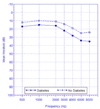Diabetes and hearing impairment in the United States: audiometric evidence from the National Health and Nutrition Examination Survey, 1999 to 2004
- PMID: 18559825
- PMCID: PMC2803029
- DOI: 10.7326/0003-4819-149-1-200807010-00231
Diabetes and hearing impairment in the United States: audiometric evidence from the National Health and Nutrition Examination Survey, 1999 to 2004
Abstract
Background: Diabetes might affect the vasculature and neural system of the inner ear, leading to hearing impairment.
Objective: To determine whether hearing impairment is more prevalent among U.S. adults with diabetes.
Design: Cross-sectional analysis of nationally representative data.
Setting: National Health and Nutrition Examination Survey, 1999 to 2004.
Participants: 5140 noninstitutionalized adults age 20 to 69 years who had audiometric testing.
Measurements: Hearing impairment was assessed from the pure tone average of thresholds over low or mid-frequencies (500, 1000, and 2000 Hz) and high frequencies (3000, 4000, 6000, and 8000 Hz) and was defined as mild or greater severity (pure tone average >25 decibels hearing level [dB HL]) and moderate or greater severity (pure tone average >40 dB HL).
Results: Hearing impairment was more prevalent among adults with diabetes. Age-adjusted prevalence of low- or mid-frequency hearing impairment of mild or greater severity in the worse ear was 21.3% (95% CI, 15.0% to 27.5%) among 399 adults with diabetes compared with 9.4% (CI, 8.2% to 10.5%) among 4741 adults without diabetes. Similarly, age-adjusted prevalence of high-frequency hearing impairment of mild or greater severity in the worse ear was 54.1% (CI, 45.9% to 62.3%) among those with diabetes compared with 32.0% (CI, 30.5% to 33.5%) among those without diabetes. The association between diabetes and hearing impairment was independent of known risk factors for hearing impairment, such as noise exposure, ototoxic medication use, and smoking (adjusted odds ratios for low- or mid-frequency and high-frequency hearing impairment were 1.82 [CI, 1.27 to 2.60] and 2.16 [CI, 1.47 to 3.18], respectively).
Limitations: The diagnosis of diabetes was based on self-report. The investigators could not distinguish between type 1 and type 2 diabetes. Noise exposure was based on participant recall.
Conclusion: Hearing impairment is common in adults with diabetes, and diabetes seems to be an independent risk factor for the condition.
Figures






Comment in
-
Hearing loss and diabetes: you might not know what you're missing.Ann Intern Med. 2008 Jul 1;149(1):54-5. doi: 10.7326/0003-4819-149-1-200807010-00232. Epub 2008 Jun 16. Ann Intern Med. 2008. PMID: 18559823 No abstract available.
Summary for patients in
-
Summaries for patients. Does diabetes affect hearing?Ann Intern Med. 2008 Jul 1;149(1):I20. doi: 10.7326/0003-4819-149-1-200807010-00233. Epub 2008 Jun 16. Ann Intern Med. 2008. PMID: 18559824 No abstract available.
References
-
- Pleis JR, Lethbridge-Cejku M. Summary health statistics for U.S. adults: National Health Interview Survey 2005. Vital Health Stat 10. 2006;(232):1–153. - PubMed
-
- Cruickshanks KJ, Tweed TS, Wiley TL, et al. The 5-year incidence and progression of hearing loss: the epidemiology of hearing loss study. Arch Otolaryngol Head Neck Surg. 2003;129(10):1041–1046. - PubMed
-
- Muhr P, Mansson B, Hellstrom PA. A study of hearing changes among military conscripts in the Swedish Army. Int J Audiol. 2006;45(4):247–251. - PubMed
-
- Dalton DS, Cruickshanks KJ, Wiley TL, Klein BE, Klein R, Tweed TS. Association of leisure-time noise exposure and hearing loss. Audiology. 2001;40(1):1–9. - PubMed
-
- Cruickshanks KJ, Klein R, Klein BE, Wiley TL, Nondahl DM, Tweed TS. Cigarette smoking and hearing loss: the epidemiology of hearing loss study. Jama. 1998;279(21):1715–1719. - PubMed
Publication types
MeSH terms
Substances
Grants and funding
LinkOut - more resources
Full Text Sources
Medical
Miscellaneous
